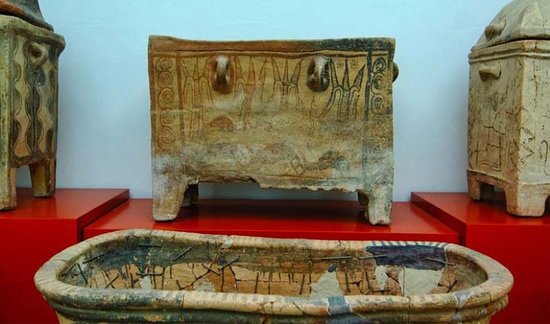
Archaeological Museum of Agios Nikolaos
The Archaeological Museum of Agios Nikolaos was founded in 1970 to exhibit the numerous findings from eastern Crete that until then were displayed at the Museum of Heraklion. The exhibition covers the period from the Neolithic years until the end of the Greco-Roman period. It is divided into five rooms and the visitor can follow the evolution of art in the area through representative samples of different techniques and eras.
In the first room, a highlight that stands out is the phallus-shaped figurine from the cave of Pelekites of Zakros. Also on display are offerings found in 1971 in the seaside cemetery of Agia Fotia. This cemetery, the largest in its number of tombs in prehistoric Crete and one of the largest in Greece, had at least 260 graves with over 1,600 vessels, bronze artefacts and blades (3,000 – 2,300 BC). Moving on to the second room we meet the most famous object of the Museum `The Goddess of Myrtos”. It is an exquisite vessel shaped in the form of a female figure with a very small head on a tall, slender neck and a bell-shaped body. Both hands are used to hold together the spout or nozzle of the jug from where the liquid contained within would have flowed. Gold jewerly, and various other stone vessels from the early Minoan cemetery (2600 – 2000 BC) are exhibited in this gallery.
The third room is dedicated to the Neo-Palatial period (1700-1450 BC) with sarcophagi of the neo-Palatial and the post-Palatial period on display. In the fourth room, we find a child’s burial pithos from the New Palace Period that was discovered and is exhibited in its entirety. Many samples of Late Minoan pottery and everyday items including a potter’s wheel are on display in the same room.
In the last rooms of the museum, the characteristics of the Daedalic style, in ceramic art and stone sculpture are highlighted and explained. The Daedalic style gradually disappeared and gave way to the Archaic style of sculpture. Lastly, findings from the Greco-Roman period are exhibited in Room 7. One of the most striking exhibits in this room is the skull of a young athlete, found with a golden wreath (probably from an olive tree) and a coin still in his mouth. The skull was found in the Roman cemetery at Potamos, near the city of Agios Nikolaos and is from the first century AD. The coin is characteristic of “Charon’s obol“, placed in the mouth as payment to the ferryman, Charon, to secure passage to the afterlife.